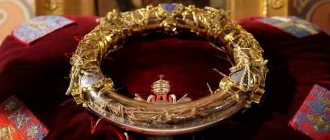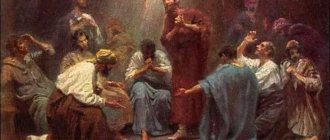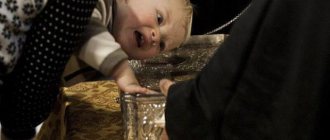Christianity is one of the most widespread religions. Each temple or piece of church utensils is a real work of art, the oldest of which cost fabulous amounts of money. But the value of a Christian relic is not determined by its beauty, but by its religious significance. Any indirect relationship to Christ makes a thing priceless.
Items related to the life and death of Jesus Christ have been revered by believers for centuries. Relics are kept in the largest temples in the world. Their authenticity is difficult to prove even to modern science. But whether you believe they are real or not, the relics' own history is very interesting. You may be interested in the article 10 false gods of our time.
Nails of the Holy Cross
Experts around the world argue about how many nails were used during the crucifixion of Christ. Some say three, others say four. Their exact number is unknown, but there are several so-called nails of the Holy Cross that have been revered for many years. According to legend, Emperor Constantine the Great sent his mother Helen to Jerusalem in search of the Cross. Upon her return, Elena brought with her particles of the Life-Giving Cross and nails with which Christ was crucified.
Constantine forged one of the nails into his helmet, and inserted the second into the bridle of his horse. The last, third nail, was reforged into the so-called Iron Crown of the Lombard Kingdom. In addition, there are about 30 more nails scattered throughout Europe, revered as relics. But most likely, some of them have nothing to do with Christ.
Relics in Orthodoxy
The Orthodox Church previously focused on the worship of icons rather than relics. Later, the pilgrimage of Orthodox believers to various countries of the world began to develop to worship shrines, the custodians of which are now representatives of other Christian churches. As a rule, Orthodox pilgrims are given permission for this and kind assistance is provided. In an effort to create the image of the “Second Jerusalem” and the “Third Rome,” Orthodox sovereigns and patriarchs collected Christian shrines , which are available to believers in most churches of the Orthodox Church. In Russia, most of the relics are in the Kremlin museums - the Armory Chamber, the Assumption Cathedral. Among the main shrines are particles of the Robe of Christ, a Nail from the Holy Cross, and particles of the Robe of the Mother of God. A unique relic is the ark of Dionysius of Suzdal with a particle of the tree of the Life-giving Cross of the Lord and 16 other shrines, among which are particles of Christ’s tunic, the crown of thorns, and the aromas with which the Savior’s body was anointed before burial.
crown of thorns
The crown of thorns from the head of Christ has been studied by scientists for a long time, but there is no scientific evidence of its authenticity. However, this does not prevent millions of believers from revering it as a shrine. The fate of the crown of thorns was not easy. In 1238, Emperor Baldwin II pawns the crown in a Venetian bank due to financial difficulties.
But thanks to the King of France, Louis the Saint, who bought the crown for a lot of money, the relic was transported to Notre-Dame de Paris in August 1239, where it is kept to this day. The crown originally had 70 thorns, but over the centuries the thorns were divided between French kings and Byzantine emperors.
Shroud of Turin
The first written mentions of the Shroud of Turin appear in the 14th century. The relic was passed from hand to hand over the centuries until it was placed in the Cathedral of John the Baptist in Turin in 1578. The Shroud of Turin is the most famous, studied and at the same time controversial shrine of the Christian world . The Catholic Church has not yet made an official statement about its position regarding it.
According to radiocarbon dating in 1988, the shroud was made between 1260 and 1390. Subsequent studies also show that her age is much younger than expected. Although some experts argue that the research results may be unreliable. At the same time, some believers from all over the world are sure that this is the same shroud in which the body of Christ was wrapped after death.
Relics associated with saints
Head of John the Baptist
John the Baptist was beheaded by Herod Antipas due to the machinations of the Jewish princess Herodias and her daughter Salome. According to legend, the head kept by Herodias was taken out of the palace by one of her maids, after which the shrine was secretly buried. The Orthodox Church celebrates the three Findings of the Head of John the Baptist. The Catholic considers the only authentic head, which is kept in the Church of San Silvestro in Capite in Rome. Followers of Islam, in turn, claim that the head of John the Baptist is in the Umayyad mosque in Damascus. However, there are several other places where the head is also believed to be kept: Amiens, Antioch and Armenia.
Popularity: the total number of pilgrims who annually seek to see the head of John the Baptist in all these places amounts to hundreds of thousands.
Hand of John the Baptist
The relic is the incorruptible right hand of the holy prophet John the Baptist. One of the most revered shrines of the Christian world , since according to the Bible, John the Baptist laid his right hand on the head of Jesus Christ during Baptism. The relic is kept in the Cetinje Monastery in Montenegro.
Chains of St. Peter
Chains (chains) with which, according to legend, the Apostle Peter was shackled during his arrests. The Orthodox Church has established the celebration of worship of the honorable chains of the Apostle Peter, which takes place on January 16 (according to the Julian calendar).
Sword of Saint Peter
The sword of St. Peter is a relic identified with the sword with which, according to the Gospels, the Apostle Peter, moved by ardent love and devotion, cut off the right ear of the high priest’s servant, Malchus, during the capture of Christ. This incident is mentioned in all four gospels, although only one Gospel of John allows us to clarify the names of the characters. Kept in the Archdiocese Museum (Poznan). An exact copy of the sword of St. Peter (by Bohdan Puchalski) is kept in the Basilica of St. Peter and St. Paul in Poznań.
While the soldiers appeared at night in the Garden of Gethsemane with the aim of taking Jesus into custody, only one disciple stood up for the Lord - the Apostle Peter. Drawing a sword, he cut off the ear of one of those who came, but the Savior, even in His dying hour, healed the slave. Peter's use of weapons and Christ's reaction served as the basis for further semi-religious secular discussions about whether the Lord was a pacifist.
The sword is made from a single piece of iron, only the guard was forged separately. Its length is 70.2 centimeters, and the sword was originally 1 or 2 centimeters longer. Width - up to 9.4 centimeters. On the handle of the sword there is a hole with a diameter of 0.4 centimeters and a depth of 10.3 centimeters. The sword was engraved with "In the beginning was the Word."
The scene in which the Apostle Peter cuts off the ear of the slave Malchus served as a motif for many works by European painters and often accompanies the main episode of the taking of Christ into custody, and is also present in the bas-reliefs and paintings of many cathedrals and churches, both Catholic and Orthodox. In particular, the scene can be seen among the paintings of the Church of Theodore Stratelates.
Sir (veil)
After the crucifixion of Jesus, the disciples wrapped his body in a shroud and placed a sour (Latin name for a handkerchief for wiping sweat from the face) on his face to dry it. Sudar - a piece of linen fabric with traces of blood and ichor. A brief mention of it as a funeral payment is contained in the Gospel of John. Most of the information known about the relic was recorded in the 12th century by Pelagius, Bishop of Oviedo. A little earlier, in 1075, the casket in which the sir was kept was found by the national hero of Spain, known as El Cid Campeador.
Now the monastery is kept in Oviedo, where pilgrims can see it three times a year. Radiocarbon dating dates the relic to 700 AD. This means that the sir is older than the shroud, and they could not have been used at the same time. This also casts doubt on its authenticity, if the analysis is to be believed.
Christ's manger
Reliquary with the manger of Christ in the Church of Santa Maria Maggiore in Rome Wikimedia Commons
Two relics are associated with the manger of Jesus, that is, the cattle feeder that served as the cradle of Christ. Firstly, under the pulpit of the Basilica of the Nativity in Bethlehem there is a small chapel, inside of which a depression is marked in marble, where, according to legend, the cradle of Jesus stood. The second is the manger itself (or rather, its wooden part), which in the 7th century, by order of the Pope, was taken to Rome after Jerusalem was captured by the Persians. The manger is still kept in Rome - in the Church of Santa Maria Maggiore.
Veronica Plat
According to legend, when Jesus was carrying the cross to Calvary, a pious woman named Veronica gave him a cloth to wipe the sweat from his forehead, after which an image of Christ’s face appeared on the cloth. However, this incident is not described in the Bible. Since the 17th century, the Verona board was considered lost. According to some reports, it was stolen from the Vatican.
Not long ago, Frank Heinrich Feiffer, a German priest from the Jesuit order, a teacher at the Gregorian University in Rome, discovered the Verona plate in the small Italian village of Manopello. Proving the authenticity of a relic is difficult due to its age and risk of damage. However, some experts and many believers are inclined to believe that this board is real.
Blood of Christ
After Christ's crucifixion, Joseph of Arimathea, one of his secret followers, wipes the blood from Jesus' face with a piece of cloth. According to legend, this fabric was kept in Jerusalem until the Second Crusade, when King Baldwin III gave the relic to Thierry of Alsace, Count of Flanders. When the Count returned to his hometown of Bruges in Belgium, he ordered the cloth to be placed in the chapel of the Basilica of the Holy Blood.
The shrine is kept there to this day in a bottle decorated with gold and angels. Surprisingly, the bottle has never been opened . Modern research has shown that it is made of rock crystal, and is believed to have originally been a perfume bottle.
Every year on the day of the Ascension of the Lord, the city hosts a holiday in honor of the Blood of Christ, which attracts tourists from all over the world. The Bishop of Bruges carries a bottle through the streets, followed by the townspeople, recreating biblical events.
Spear of Longinus
According to legend, Gaius Cassius Longinus, a Roman centurion, plunged a spear into the hypochondrium of the crucified Jesus Christ. There are several spear fragments in the world that claim to be authentic. One of the copies was found in 1908 during the First Crusade in Antioch by an impoverished monk named Peter Bartholomew.
According to the monk, the Apostle Andrew appeared to him and said that the Spear was hidden under St. Peter's Cathedral in the city. Peter Bartholomew told Count Raymond and Bishop Le Puy about his vision. The bishop was skeptical about his words, but the count was inspired. He ordered his men to start digging under the cathedral, but they found nothing.
Then Peter Bartholomew jumped into the dug trench and discovered a metal object that looked like a spear. And although there was no evidence that this was the Spear of Longinus, the crusaders who were under siege believed in the find and found the strength to break the blockade of the city.
Relics associated with Jesus
Many relics associated with Jesus have been sought after and revered throughout Christian history. Some people believe in their authenticity, others doubt it. For example, in the 16th century, Catholic theologian Erasmus of Rotterdam wrote sarcastically about the number of buildings that could be built from wood, which was said to be part of the cross on which Christ was crucified. In addition, while experts were debating whether Christ was crucified with three or four nails, there were at least thirty nails.
Some relics are more revered than others. Thus, a relic revered as the Crown of Thorns of God attracts fewer pilgrims than a relic such as the Shroud of Turin.
Shroud of Turin
It is the most famous relic. This is the cloth in which the body of Jesus Christ was wrapped after his death. There were bloody marks on it from the wounds of the body of Christ. In addition, scientists were able to detect the face of Jesus Christ on it and restore his image. It owes its name “Turinskaya” to the city of Turin, Italy, in which it is kept. Some believers are convinced that the shroud contains genuine imprints of the Face and Body of Christ, which is why the Shroud of Turin is valued as one of the most important relics of Christianity. The Catholic Church does not officially recognize the shroud as authentic, but considers it an important reminder of the Passion of Christ. The Orthodox Church has no official position on the issue of its authenticity; a number of church leaders consider it genuine.
Popularity: in 2010, the relic was opened for pilgrimage for the first time in the new millennium, and 2.1 million people saw it in 45 days.
crown of thorns
The crown placed on the head of the Lord (27:29). According to most interpreters, it was made from white thorns, which grew in abundance in the vicinity of Jerusalem.[10]. A description of the relics of the passion of Christ made by Nikolai Mesarit, the sacristan of the sovereign's temple, has survived to this day. It was compiled in 1200, that is, exactly four years before the sack of Constantinople by the crusaders. He notes that the crown miraculously blooms and seems to remain incorruptible, that it is “smooth and delicate” and does not have sharp thorns, but rather resembles flowers. At the end of the 19th century. the crown was sealed in a ring-shaped glass flask, and scientific research on the plants was never carried out. It is noteworthy that the absence of real thorns did not prevent the French kings from sending relics of “thorns from the crown of thorns” to various countries of the Christian world as a particularly valuable gift. The relic is located in Paris, in the Cathedral of Notre Dame de Paris, and individual thorns are in many churches around the world.
Popularity: every first Friday of the month, and during the Catholic Lent - every Friday and on Good Friday, the relic is brought out to the believers, and every time thousands of people gather to look at it.
Christ's manger
A manger is a feeding trough for pets in which, according to the Gospel story, the Mother of God placed the newborn baby Jesus as if in a cradle. There are two known relics identified with the manger of Christ - in Bethlehem and in Rome.
Relics of the Passion
These and other relics relate to the events of the Passion of Christ and are especially important in Christianity as reminders of the physical and spiritual suffering in the last days and hours of Jesus' earthly life. Relics of the Passion are artifacts especially preserved by the church for veneration and use in rituals.
The relics include part of the Instruments of the Passion as instruments of martyrdom. The most famous and revered relics:
- The Shroud of Turin is a four-meter linen cloth in which, according to legend, Joseph of Arimathea wrapped the body of Jesus Christ after His suffering and death on the Cross (Matthew 27:59-60);
- The crown of thorns, which, according to the Gospels, was placed on the head of Jesus by Roman soldiers during His reproach;
- The Life-Giving Cross on which Jesus was crucified;
- Spear of Longinus - according to one legend, it was with this spear that the Roman centurion Gaius Cassius Longinus struck the crucified Jesus Christ between the 4th and 5th ribs. Various churches around the world keep several relics that are considered to be the spear of Longinus, or a fragment of it. Among them: Vienna spear
- Armenian spear
- Vatican spear
- Krakow spear
” written according to the instructions of Pilate (John 19:19);
Sacred Prepuce
The sacred prepuce or sacred foreskin is the most unusual and valuable relic, as it is directly part of the body of Christ . Like all Jewish boys, Jesus was circumcised on the eighth day after his birth. The first mention of the sacred foreskin dates back to 800 AD, and belongs to Charlemagne. The king of the Franks claimed that he received the sacred prepuce from an angel who appeared to him. Charlemagne later gave the relic to Pope Leo III, who placed the imperial crown on its head. So Charles received the title of Roman Emperor.
Since the appearance of the relic in the Catholic Church, controversy has not subsided around it. More than 20 churches that insisted on possessing a sacred prepuce. Surprisingly, the Catholic Church has made an official statement regarding this. Pope Clement VII announced that the real foreskin of Christ was kept in the Abbey of Charoux. Meanwhile, theologians argue that the existence of the sacred prepuce is impossible, since Christ ascended to Heaven, and, therefore, all parts of his body are no longer in the human world.
Relics associated with the Virgin Mary
Belt of the Blessed Virgin Mary
A relic that, according to legend, the Virgin Mary, before her ascension, gave along with a chasuble to two Jerusalem widows (in the Catholic tradition - to the Apostle Thomas). In honor of the relic, a celebration has been established in the Orthodox Church - “The Position of the Honorable Belt of the Blessed Virgin Mary,” which takes place on August 31 (according to the Julian calendar). In the Catholic Church, the belt located in the Cathedral of St. Stephen in Prato is revered.
Popularity: More than 2.5 million Russians in 15 cities came to venerate the relic, brought from Greece to Russia for a month.
Robe of the Virgin Mary
The relic, revered in the Orthodox Church, is a garment that, according to legend, belonged to the Virgin Mary. In honor of the relic, a celebration was established - “The Position of the Honorable Robe of the Most Holy Theotokos in Blachernae” (Position of the Robe), celebrated on July 2 (according to the Julian calendar).
Savior Not Made by Hands
The Savior Not Made by Hands or the miraculous Mandylion is an image of Christ, the origin of which remains controversial. The generally accepted version is that King Abgar of Edessa sent his servant Ananias with a letter to Jesus. In the letter, he asked Christ to come and cure him of leprosy. Christ rejected the request, but blessed the king and promised to send a disciple who could cure him.
According to one version, Ananias was an artist and painted a portrait of Christ, and according to another, Christ gave Ananias a towel with which he had just wiped his face, and his image remained on the fabric. With this, Ananias returned to Abgar, and the king of Edessa found the sacred image of Christ.
Mandylion
Genoese:
Vatican:
The Mandylion, or the Savior Not Made by Hands, is the Eastern Christian analogue of the Plath of Saint Veronica. According to legend, it was made by Jesus himself, when he was still free and in good health, in response to the request of the ruler of the city of Edessa to send his image.
Available in 2 versions. The first is kept in Genoa, in the Armenian Church of St. Bartholomew. The other is now kept in the Vatican Palace, in the Chapel of St. Matilda.
Holy Grail
Despite what Monty Python and Dan Brown may say, the Holy Grail is just the cup from which Christ drank at the Last Supper, and into which Joseph of Arimathea collected the blood from the wounds of the crucified Jesus. In Christianity, the crucifixion and blood of Christ have a special meaning, so the Grail is of great interest to believers and researchers.
There are several bowls that claim to be authentic. The most famous is the cup from the Valencia Cathedral, which has a certificate of authenticity from 262 AD. The cup is said to have been used by the first 22 popes, from St. Peter to Pope Sixtus II, who passed it on to St. Lawrence.
Relics and shrines of the Christian world
Christian relics are objects, relics and objects sacredly preserved and revered by Christians, associated with events of the past, with attributes of the life of saints, prophets or God.
All Christian relics are consecrated by the church and are objects of worship, of varying degrees of importance depending on the significance of the event or saint. By venerating holy relics, Christians thereby honor the saint himself. The veneration of relics is of great importance in Christianity, mainly in Catholicism. The Orthodox Church places more emphasis on the worship of icons rather than relics.










